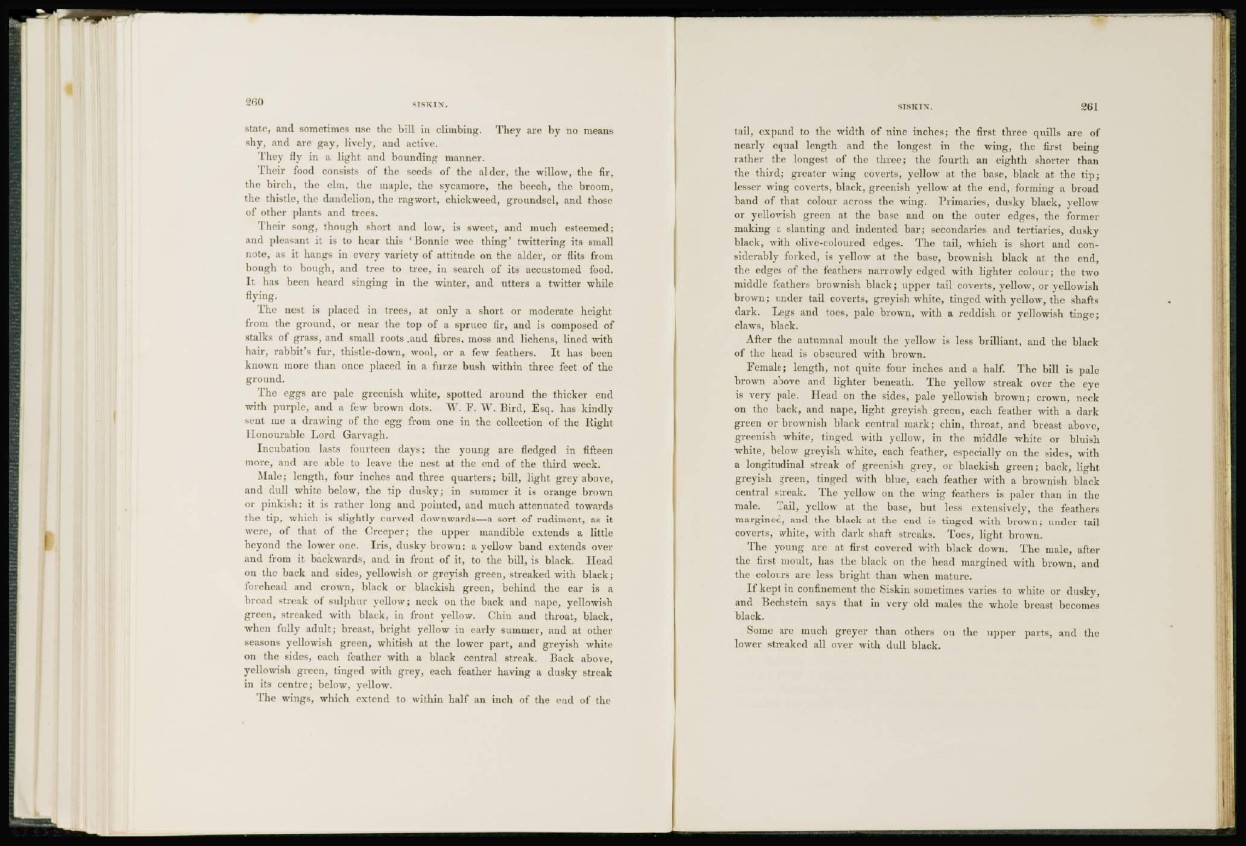
260 SISKIN.
stale, ami sometimes use the bill in climbing. They are by no means
shy, and are gay, lively, and active.
Thcv fly in • light and bounding manner.
Their food consists of the seeds of the alder, the willow, the fir,
the birch, the elm, the maple, the sycamore, the beech, the broom,
the thistle, the dandelion, the ragwort, chickweed, groundsel, and those
of other plant* and trees.
Their song, though short and low, is sweet, and much esteemed;
and pleasant it is to hear this 'Bonnie wee thing1 twittering its small
nolo, as it hangs in every variety of attitude on the alder, or flits from
bough to bough, and tree to tree, in search of its accustomed food.
It has been heard singing in the winter, and utters a twitter while
flying.
The nest is placed in trees, at only a short or moderate height
from the ground, or near the top of a spruce fir, and is composed of
stalks of grass, and small roots .and fibres, moss and lichens, lined with
hair, rabbit's fur. thistle-down, wool, or a few feathers. It has been
known more (ban once placed in a furze bush within three feet of the
ground.
The eggs are pale greenish white, spotted around the thicker end
with purple, and a few brown dots. W. F. W, Bird, Esq. has kindly
sent nic a drawing of the egg from one in the collection of the Bight
1 [onourable Lord Garvagh.
Incubation lasts fourteen days; the young arc fledged in fifteen
more, and are able to leave the nest at the end of the third week.
Male; length, four inches and three quarters; bill, light grey above,
and dull white below, the tip dusky; in summer it is orange brown
or pinkish: it is rather long and pointed, and much attenuated towards
the tip, which is slightly curved downwards—a sort of rudiment, as it
were, of that of the Creeper; the upper mandible extends a little
beyond the lower one. Iris, dusky brown: a yellow band extends over
and from it backwards, and in front of it, to the bill, is black. Head
on tin- back and sides, yellowish or greyish green, streaked with black;
forehead and crown, black or blackish green, behind the ear is a
broad streak of sulphur vellow; neck on the back and nape, yellowish
green, streaked with black, in front vellow. Chin and throat, black,
when fully adult; breast, bright yellow in early summer, and at other
seasons yellowish green, whitish at the lower part, and greyish white
on the sides, each feather with a black central streak. Back above,
yellowish green, tinged with grey, each feather having a dusky streak
in its centre; below, yellow.
The wings, which extend to within half an inch of the end of the
SISKIN. 261
tail, expand to the width of nine inches; the first three quills are of
nearly equal length and the longest in the wing, the first being
rather the longest of the three; the fourth an eighth shorter than
the third; greater wing coverts, yellow at the base, black at the tip;
lesser wing coverts, black, greenish yellow at the end, forming a broad
band of that colour across the wing. Primaries, dusky black, yellow
or yellowish green at the base and on the outer edges, the former
making a slanting and indented bar; secondaries and tertiaries, dusky
black, with olive-coloured edges. The tail, which is short and considerably
forked, is yellow at the base, brownish black at the end,
the edges of the feathers narrowly edged with lighter colour; the two
middle feathers brownish black; upper tail coverts, yellow, or yellowish
brown; under tail coverts, greyish white, tinged with yellow, the shafts
dark. Legs and toes, pale brown, with a reddish or yellowish tinge;
claws, black.
After the autumnal moult the yellow is less brilliant, and the black
of the head is obscured with brown.
Female; length, not quite four inches and a half. The bill is pale
brown above and lighter beneath. The yellow streak over the eye
is very pale. Head on the sides, pale yellowish brown; crown, neck
on the back, and nape, light greyish green, each feather with a dark
green or brownish black central mark; chin, throat, and breast above,
greenish white, tinged with yellow, in the middle white or bhnsh
white, below greyish white, each feather, especially on the sides, with
a longitudinal streak of greenish grey, or blackish green; back, light
greyish green, tinged with blue, each feather with a brownish black
central streak. The yellow on the wing feathers is paler than in the
male. Tail, yellow at the base, but l e s s extensively, the feathers
margined, and the black at the end is tinged with brown; under tail
coverts, white, with dark shaft streaks. Toes, light brown.
The young are at first covered with black down. 'The male, after
the first moult, has the black on the head margined with brown, and
the colours are less bright than when mature.
If kept in confinement the Siskin sometimes varies to white or dusky,
and Bechstein says that in very old males the whole breast becomes
black.
Some arc much greyer than others on the upper parts, and the
lower streaked all over with dull black.